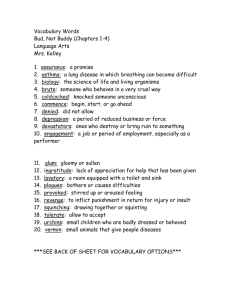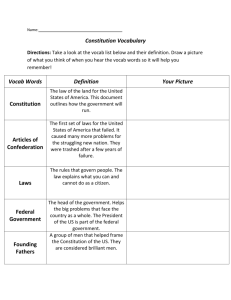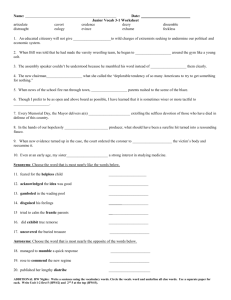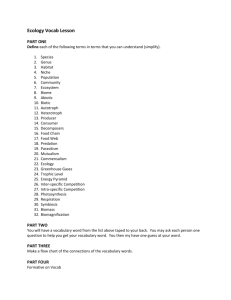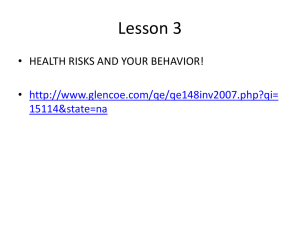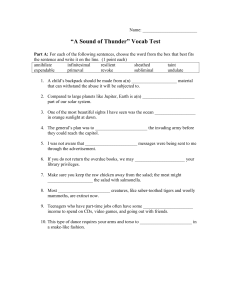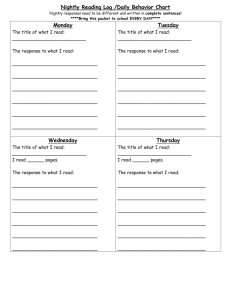Parent teacher conference Stuff!!
advertisement
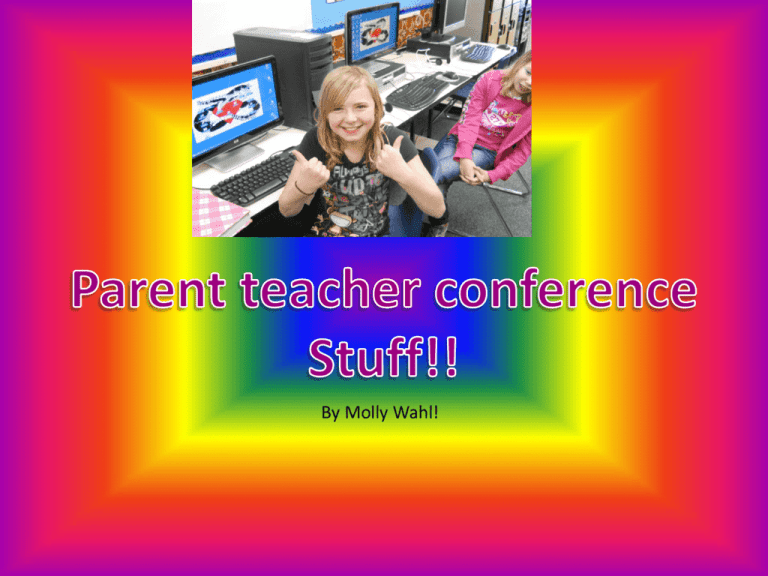
By Molly Wahl! Lesson 1- 10+156+8+27=201 Lesson 2- If the factors are 7 and 11 what is the product? 77 Lesson 3- A+16=48 what is the unknown number? A=32 Lesson 4- J x 5=60 what is the unknown number? J=12 Lesson 5- 144 (8 x 6) = 3 Lesson 6- What fraction of this circle is shaded? 1/4 Lesson 7- A meter stick is 100 centimeters long . 100 centimeters is how many millimeters?1000 Lesson 8- What is the perimeter of a square tile with sides 12 inches long? 48 inches. Lesson 9- Arrange these numbers in order from least to greatest: 1,0,1/2 : 0,1/2, 1. Lesson 10- Is the number 1492 even or odd? Even. Lesson 11- Marcia went to the store with $20.00 and returned home with $7.75. How much money did she spend? $12.25. Lesson 12- In the number 5,764,283,000, what is the place value of the digit 4? Millions. Lesson 13- The population of Castor is 26,290. The population of Weston is 18,962. How many more people live in Castor then Weston? 7,328 people. Lesson 14- What number is 8 less than 6? -2 Lesson 15- Reggie sold buttons with a picture of his school mascot for $0.75. If Reggie sold 7 buttons, how much money did he receive?$5.25. Lesson 16- round 550 to the nearest hundred. 600 Lesson 17- On an inch ruler which mark is halfway between the ¼ inch mark and the ½ inch mark? 3/8 Lesson 18- Find the average of 9,7, and 8. 8 Lesson 19- Which of these number is a prime number? 2, 22, 222? 2. Lesson 20- Find the GCF of 12 and 20. 4 Lesson 21- Which of these numbers is divisible by 9? 365, 1,179, 1,556. 1,179 Lesson 22- If 2/3 of the apples were eaten how many were eaten? 8 apples. Lesson 23- If a team lost 9 games and won 5 games, then what is the teams win loss ratio? 5 to 9. Lesson 24- ¼ + 2/4 = ¾ Lesson 25- What fraction of a circle is 331/3 of a circle?1/3 Lesson 26- Add and simplify: 2/5 + 4/5 . 1 1/5 Lesson 27- What is the name of the perimeter of the circle? Circumference. Lesson 28- What is the angle called that is below 90 degrees? Acute. Lesson 29- Reduce 16/24: 2/3 Lesson 30- What is the LCM of 2 and 4? 4 Lesson 1- Vocab: ecstatic: showing or feeling pleasure. Mirth: happiness or enjoyment. The story was realistic fiction which means it has characters and events that are like people and events in real life. Lesson 2- Vocab: emerged: to appear out of or from behind something. Tormented: to torture or hurt. The story was historical fiction which means it has people, places, and events from the past. Lesson 3- Vocab: rigged: to assemble something. Scheme: a secret and cunning plan. The story was a biography which means a story told about a persons life and was written by someone else. Lesson 4- Vocab: luxury: something very comforting . Intense: extreme or strong in a way that can be felt. The story was a biography. Lesson 5- Vocab: sage: someone who is known as knowledgeable or wise. Trepidation: fearful or anxious about something that is going to happen. The story was fiction which means not true. Lesson 6- Vocab: jest: something said or done in a playful manner. Supple: flexible and elastic. The story was realistic fiction. Lesson 7- Vocab: rejected : to refuse or not accept. Disown: to refuse or no longer acknowledge. The story was realistic fiction. Lesson 8- Vocab: rendezvous: a meeting arranged for an agreed time or place. The story was Narrative nonfiction which means it tells about people, things, events or places that are real. Lesson 1- Absences: somebody that is not present. Circuit: a route that is a curved path and it ends where it begins. Lesson 2- Proclaim: to announce something publically or formally. Quaint: an old fashioned quality. Lesson 3- Ointment: a smooth substance used on the skin. Moisture: wetness, especially as droplets of condensed liquid. Lesson 4- Employed: to hire someone. Multiplied: to increase by a number. Lesson 5- Turquoise: a bluish green color. Replied: to say something in response. Lesson 6- Cuticle: an edge of hard skin at the base of a fingernail or toenail. Swindle: to obtain something from somebody. Lesson 7- Associate: to connect one thing with another one. Franchise: to sell a company's products. Lesson 8- Humane: showing compassion. Sequel: a movie, novel, or play that continues a story that continues a movie, novel, or play. Lesson 1- Kinds of sentences. The sentences are declarative, imperative, exclamatory, and interrogative. Lesson 2- Subjects and predicates. The subject is what the sentence is about and the predicate is what the subject is doing. Lesson 3- Compound subjects and predicates. More than one subject or predicate in a sentence. Lesson 4- Simple and compound sentences. A simple sentence is a sentence with only one subject and predicate. A compound sentence is a sentence with more than one. Lesson 6- Prepositional phrases. A prepositional phrase starts where it says where. Lesson 7- Independent clauses and dependent. An independent clause is the part of a sentence that can stand alone. A dependent clause is the part of the sentence that cannot stand alone. Lesson 8- Complex sentences. A complex sentence is a sentence that is put together with a conjunction. Chapter 1- In chapter 1 we learned about cells and systems. The parts of cells are the cell membrane, nucleus, vacuoles, cytoplasm, mitochondria and chromosomes. The systems are digestive, excretory, circulatory, and respiratory. Chapter 2- In chapter 2 we learned about classification like plant classification and animal classification. A way to classify animals is vertebrates and invertebrates. Vertebrates are animals with a backbone. Invertebrates are animals without a backbone. One way to classify plants is vascular and nonvascular. Vascular plants have tubes and nonvascular don’t have any. Chapter 3- In chapter 3 we learned about mitosis and meiosis and also life cycles. Meiosis is the process that reduces the number of chromosomes in reproductive cells. Mitosis is the process of cell division. Life cycles are like direct development and metamorphosis. Direct development is when the babies look just like their parents when they are born except in size. Metamorphosis is when there is changes when the body matures and grows. Chapter 4- In chapter 4 we learned about the common parts of vascular plants and uses of plants. Parts of the nonvascular plants are xylem, and phloem. They also have chlorophyll. The uses of plants is that they give us food and medicine. Chapter 5- We learned about how natural resources are reused and why the water cycle is important. A way natural resources are reused is when there are materials in a plant or animal body and when they die their bodies decay and the materials go into the soil. The way the water cycle works Is the sun changes water on earths surface into water vapor . There the water vapor turns back to liquid. Tiny drops of water appear and make a cloud when the cloud gets heavy it may rain or snow. Chapter 6- We learned about ecosystems and how energy is transferred in an ecosystem. An ecosystem is a community and its physical environment working together. Energy is transferred in an ecosystem by Animals eating a plant and an animal eating that animal and when that animal is dead it decomposes in the soil and plants grow again. Chapter 1- Prejudice: a preformed opinion usually an unfavorable one. Federal: involving or supporting the union during the civil war. Perspective: a particular evaluation of a situation usually from one persons point of view. Diversity: a variety of something. Unity: the state or condition of being one. Chapter 2- Megalopolis: an area where there are cities whose suburbs are almost meeting. Interdependent : unable to exist or survive without each other. Conservation: the preservation, management, and care of natural and cultural resources. Precipitation: rain, snow, or hail all of which are formed of condensation of moisture in the atmosphere. Fossil fuel: any carbon containing any fuel derived from the decomposed remains of plants and animals. Chapter 3- Surplus: an amount remaining after the original purpose has been served or the original requirement met. Civilization: a society that has a high level of culture and social organization. Empire: a group of nations, territories, or peoples ruled by a single authority. Artifact: an object made by human being. Specialize: to devote time exclusively to a an interest, skill, or field of study. Chapter 4- Potlatch: a ceremony of feasting in which the host gains prestige by giving gifts or sometimes destroying wealth. Totem pole: a tall carved log used by Native Americans of the northwest cost to honor someone or a special event. Kachina: in pueblo religion, the living the living spirit of an ancestor who helps bring rains and makes crops grow. Travois: a sled like device used for carrying people and belongings. Adobe: a type of clay in the ground used for building things.
